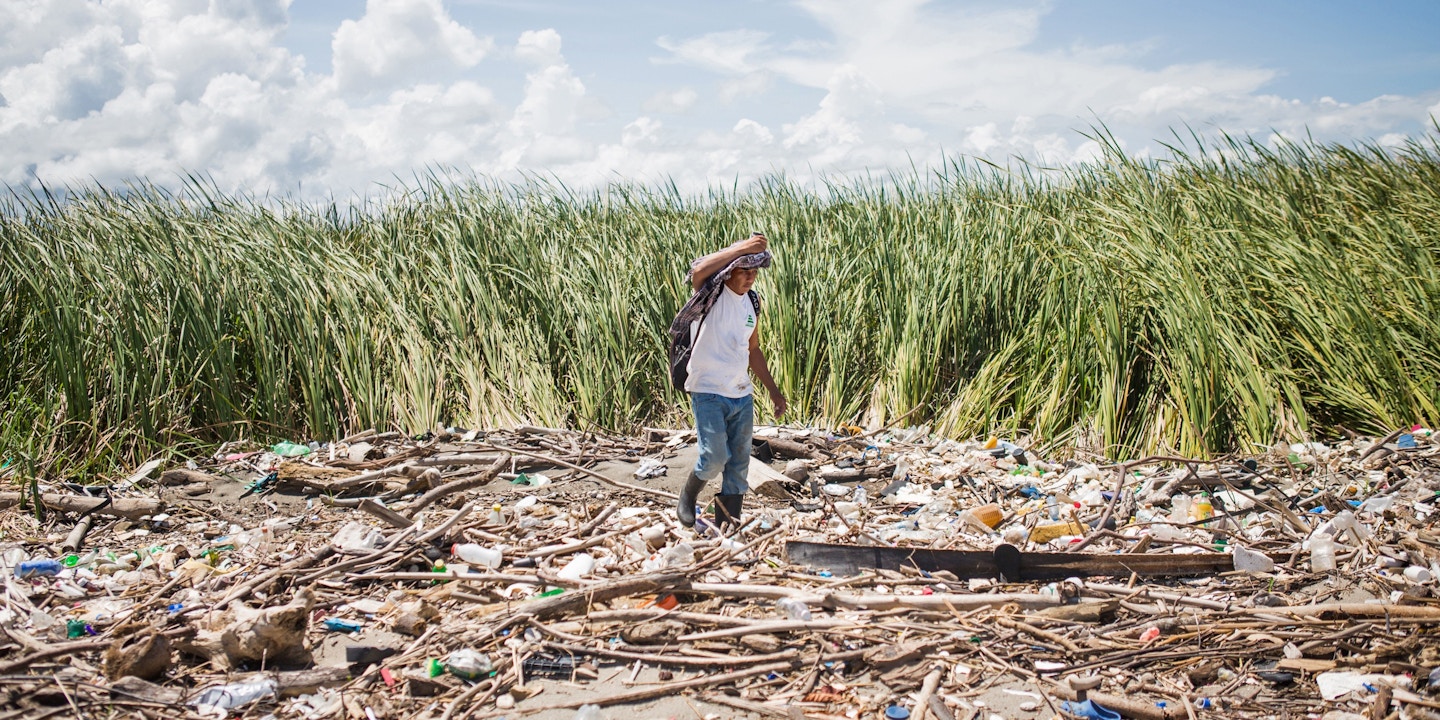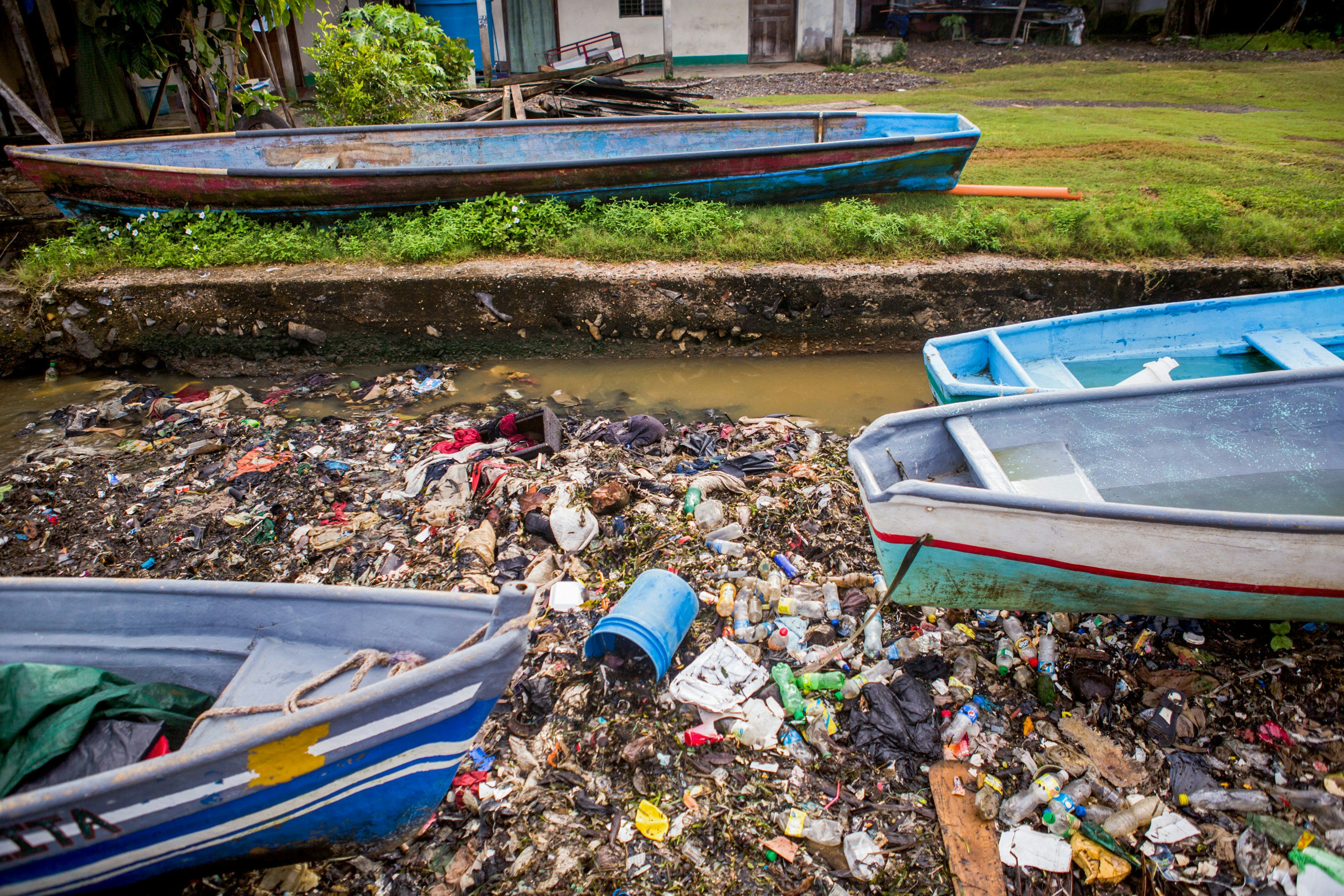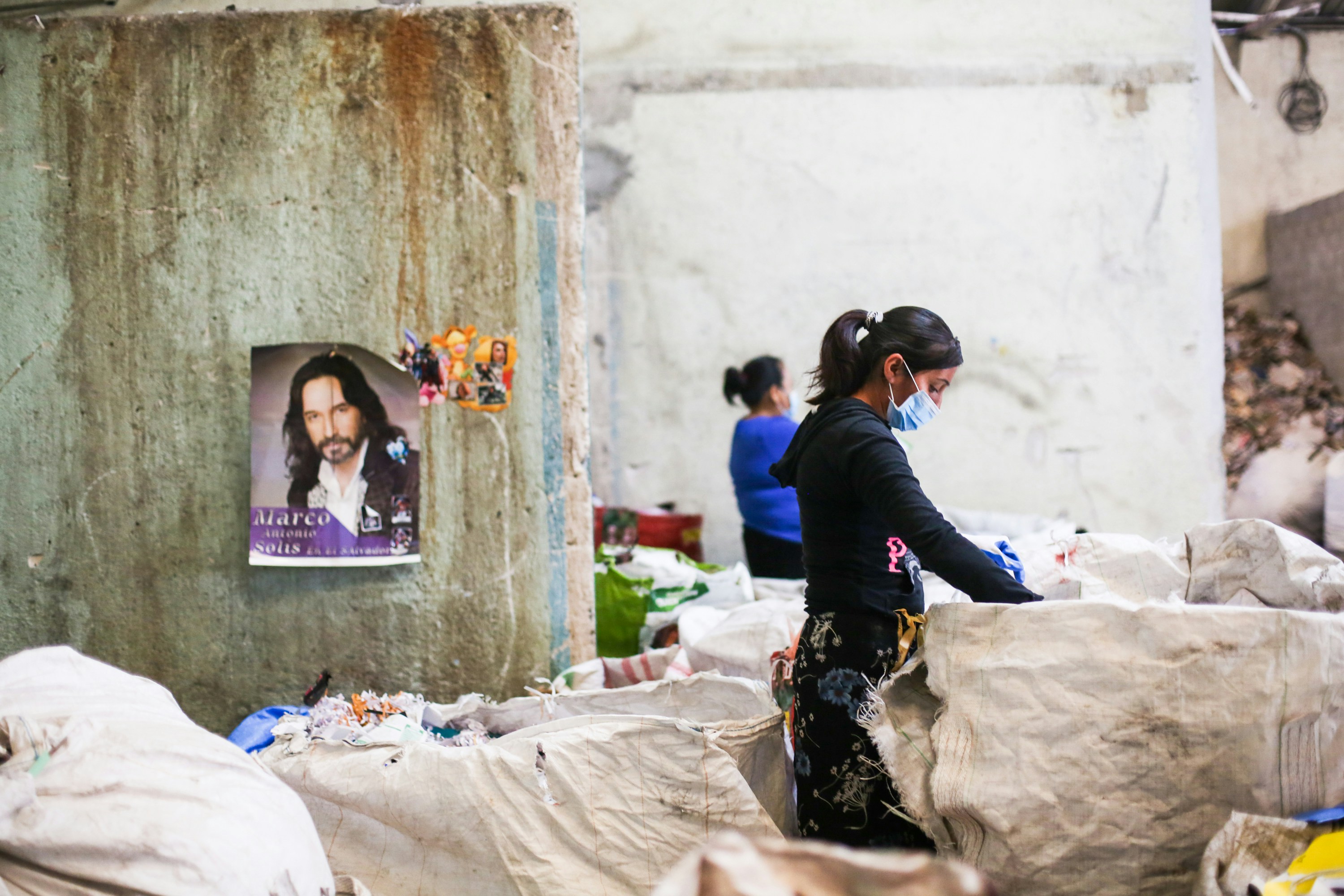RIVER OF TRASH

THE FISHERMEN STAND thigh-deep in the muddy water as our boat pulls up to the shore, grass shushing against the hull. It is a still, cool morning and mist wicks off the river as the sun begins to rise above the trees. Down the beach, a white egret standing in the shallows takes flight in a burst of sound as the fishermen lift their net to reveal its glinting catch. Beside them, half-submerged, a plastic soda bottle noses purposefully past, toward the sea.
As I step onto shore, I notice more bits of plastic lying among the reeds, half-buried in the mud, as well as stained scraps of cloth, bits of packing foam, a single cracked plastic sandal. Just beyond, Guatemala’s Motagua River pours into the Caribbean, carrying with it a daily freight of trash washed out of overcrowded city dumps and unofficial landfills hundreds of miles upstream.
Worldwide, an estimated 80 percent of ocean plastic comes from land as “mismanaged waste.” Indeed, in Guatemala, there are almost no properly managed landfills and virtually no public water treatment plants. The result is a noxious chowder of sewage, industrial and agricultural runoff, and an ever-replenished flotilla of plastic trash, churning out from the river mouth toward the massive Mesoamerican reef, which has long supported rich biodiversity and fishing communities from Cancún to Nicaragua. Now, the beaches here and in neighboring Honduras are regularly buried in artificial tidewrack of toothbrushes, makeup containers, old syringes and bottles of IV fluid, action figures, streamers of plastic film, and foil chip bags.
Hendrik, a young employee of the country’s department of protected areas, gave me and a few colleagues a tour in late 2018. For the last year, workers employed by the environmental ministry had been cleaning this stretch of beach, carting wheelbarrow loads of trash away, but even still the sand is mosaicked with colorful bits of plastic. “It’s a constant effort,” Hendrik said. However much trash they take away, the river always brings more to replace it.
1EL QUETZALITO

THE TOWN OF El Quetzalito sits at the end of a dirt road that jounces through endless plantation rows of banana and palm trees, just a few miles from Guatemala’s border with Honduras. Just beyond the houses that stand on the bank of the Motagua, the river takes a right turn and dead-ends into the Caribbean in a muddy plume of sediment and debris.
Though this small community, home to only about 305 people, lies nearly 200 miles from the busy, exhaust-choked capital, the city’s trash floats past and washes up onto the beaches every day. In 2016, footage of a massive landslide of garbage in the overfilled Guatemala City dump reportedly killed three trash-pickers and briefly drew international attention to the untenable conditions there. But with overburdened or nonexistent infrastructure throughout Guatemala, the rainy season regularly washes large quantities of trash out of many such dumps and into the rivers every year.
With few, if any, properly contained landfills in Guatemala, the rainy season regularly washes large quantities of trash out of dumps and into the rivers.
“It’s something that’s been happening for a while now,” said Marco Dubón, who goes by Marquito. Growing up, he doesn’t remember a time when the river wasn’t full of trash. In recent years, however, it’s gotten much worse.
In 2017, threatened with a lawsuit from Honduras over its polluted beaches, Guatemala’s environmental minister introduced a device he dubbed the “bio-fence.” Made of empty plastic bottles roped together with plastic netting, the floating boom juts from shore into the main current of the river at an angle, funneling trash aside before it makes it to the sea.
The bio-fence was installed near El Quetzalito, and a small group of residents, overseen by Marquito, was employed to remove the trash caught by the boom. They would also work to clean the beach just beyond town and hopefully make a dent in the overall pollution.


Left/Top: A bloated cow corpse washes up on the beach at the mouth of the Motagua River, where it flows into the Caribbean. Right/Bottom: Mounds of plastic and Styrofoam pile up on Guatemala’s beaches, filled with everything from the expected soda bottle to combs, toothbrushes, Crocs, action figures, syringes, and IV bags. Photos: Celia Talbot Tobin
One Monday in September 2018, when we visit, there is a raft of plastic bottles and floating sticks caught in the crook of the bio-fence. The surface looks solid, but it undulates against the hull of the boat tied beside the bank. There is not too much trash coming down the river at the moment, Marquito explained, but it will come back with the rains. “When it’s full, you can practically walk on it,” he said.
For now, the workers focus on the beach instead, a quick boat ride downriver. It is early, but the sun is already heavy. A bonfire of sodden wood and unidentifiable debris sends billows of steam and acrid smoke down the beach, but most of what the workers gather goes into large sacks to be carried back to town, to the recycling center. There, clean glass and plastic will be sorted apart, and everything else compacted down into fuel for the incinerator ovens of a cement company.
The workers get about 2,800 quetzales per month, a little less than $400. The work isn’t pleasant, but it is steadier than fishing. Carlos René Ortega said that he prefers working on the beach to cleaning out the bio-fence or sorting trash in the heat of the stuffy, tin-roofed recycling center. On the beach, there’s a breeze around noon. And when they work at the bio-fence, they have to wade into the water to remove the trash. “We take turns,” he explained, “but after three or four hours, we come out itching.”




A small team of around 16 locals from El Quetzalito were hired by the Guatemalan government to manually clear the beaches with rakes and wheelbarrows, the last barrier between the rest of the country’s waste and the ocean. From top left are Carolina Ortega, Carlos René Ortega, Izak Dubón, and Miguel López. Photos: Celia Talbot Tobin
“Ten years ago, it was amazing to fish here,” Izak Dubón said, pausing to plant his spade in the sand. “You would find some big fish, you would actually make money.” Izak, 20, is tall and slender, with a surprisingly deep voice behind the aqua-blue kerchief he has tied over his mouth and nose. He used to go fishing with his dad, but now feels he has no other choice than to work for the environmental ministry. “This is a great country,” he said. “If we didn’t have all this contamination, we would have tourism.”
In the afternoon, we take the boat across the river mouth to the beach opposite. Here, no one has removed any of the trash that is now piled up into dunes so deep you cannot see the sand. A TV lies half-buried in the refuse. At the far end of the beach, the stiff-legged carcass of a cow rolls at the edge of the surface, bloated and shining, a vulture hunched over it.
Marquito, standing among the piles of plastic and driftwood, is unreadable. Quietly, as if to himself, he said, “There is work here for years.”
2UPSTREAM

SINCE THE FIRST synthetic plastic appeared in 1907, we’ve made 8.3 billion tons of the stuff, 5 billion of which is still sloshing around the world, no longer in use but not going away anytime soon. Worldwide, countries with developing economies like Guatemala account for the main source of ocean plastic. Although high-income countries like the U.S. consume at a higher rate — and therefore throw away much more plastic per capita — less developed nations often lack infrastructure for proper recycling or disposal of waste, meaning that much more of their trash ends up in the ocean.
In 2017, researchers found that 90 percent of the marine plastic washed out of just 10 rivers, including the Yangtze, the Nile, and the Ganges. These are the waterways of some of the most heavily populated areas of the world, and they carry huge amounts of plastic trash as a result. Like the Motagua, they may have minimal infrastructure for water treatment or waste disposal. Altogether, between 5 and 12 million tons of plastic flow from land into the sea every year.
With the river too contaminated to use for drinking water or irrigation, communities along the river are caught in a tightening vise of scarcity and pollution.
The cost of such heavily polluted rivers is high on land too.
“When you look at the map, Guatemala should have an abundance of water,” Gerardo Paiz explained in his office at the nonprofit Madre Selva — literally, Mother Forest — where he works as an activist and spokesperson. He gestured to a lush-looking topographical map of the country as he explained what all that jungle and mountain landscape hides. The Motagua runs about 300 miles, crossing most of the Central American isthmus, but, according to Paiz, almost all of the contamination occurs about a third of the way along its length, where it joins with tributaries carrying sewage, industrial runoff, and trash from Guatemala City.

There are no public water treatment plants in the country, Paiz said. The few wastewater plants that do exist are expensive and difficult to maintain, and many are no longer operating. In recent years, several internationally funded projects to build new wastewater infrastructure have been put on hold, possibly a result of Guatemala’s scandal-plagued government. In the meantime, untreated sewage and debris flow unimpeded into the river.
For the downstream states of El Progreso and Zacapa, water is becoming a bigger problem. These states lie along Guatemala’s “dry corridor,” an agricultural region that has been hard hit by climate change and drought in the past decade. With the river too contaminated to use for drinking water or irrigation, communities along the river are caught in a tightening vise of scarcity and pollution. These environmental problems, compounded by violence, corruption, and poverty, are among the factors driving more than 116,808 Guatemalans to try and cross the U.S. border in fiscal year 2018.
As for plastic, it’s not hard to follow the problem back to its source.
“The plastic industry is aggressively moving to increase production,” said Judith Enck, a former regional U.S. Environmental Protection Agency administrator and public policy professor at Bennington College. A 2016 report predicted that plastic production would double in the next 20 years. Enck pointed out that despite recent bad press around plastics in the U.S., petrochemical companies are still making plans for new plants to turn byproducts from fracking into plastic. “They’re just marching right ahead with literally dozens of new plants in the United States.”
“Big companies are putting out all these products that they know have no chance of being recycled. And they are selling them in places with not a lot of access to landfills.”
This gives companies a strong incentive to sell more plastic in the developing world, where growing economies have provided new markets for cheap and disposable plastic products. At a market in Puerto Barrios, a small city about 40 minutes from El Quetzalito, stand after stand displayed cheap, plastic-wrapped soccer jerseys and novelty T-shirts, baseball caps made of foam and plastic mesh, neon-colored toys, cheap sandals and shoes, and more.
One large and growing source of plastic waste is packaging, especially laminated foil packets that are frequently used for food and other single-use products like soap or shampoo. These are popular in emerging economies like Central America and Asia, Enck pointed out, because it might be affordable for people to buy small quantities of a product instead of a whole bottle. But these materials, made up of specialized plastics and foils laminated together, are rarely recyclable.
“Big companies are putting out all these products that they know have no chance of being recycled,” Enck said. “And they are selling them in places with not a lot of access to landfills.”
In other words, with business as usual today, companies design and produce nonbiodegradable, nonrecyclable materials that will be used once and then discarded to flow directly to the ocean.
3STEMMING THE FLOW

“HOW DO WE SOLVE plastic pollution at the boardroom instead of the beaches?” was the question posed by Luisa Santiago, Latin America lead for the Ellen MacArthur Foundation’s New Plastics Economy initiative. Recycling is not the answer, she said. Only 9 percent of plastics produced today are ever recycled, and most of that material can only be recycled once before it, too, heads to a landfill or dump.
“We understand that dealing with waste is part of the problem, but plastic pollution really needs to be solved upstream,” Santiago said. That means working with governments and industry to come up with better solutions to the problems that single-use plastics are meant to solve. Santiago’s organization issued an analysis in 2016 that found that $80 billion to $120 billion disappears from the economy every year in the form of single-use plastic packaging that is never recycled.
By making an economic argument against plastic, and toward a more circular economy, Santiago’s organization hopes to compel industry to change in a systematic way, instead of relying on consumers to try to make individual choices within a flawed system. “We need to redesign the system, and the consumer will be automatically shifted to that system — just as the consumer was shifted to a single-use system a couple decades ago,” she pointed out.
The keystone of the New Plastics Economy plan is a pledge to eliminate “unnecessary plastics” by 2025. Achieving this, Santiago believes, requires working with companies like Coca-Cola and Nestle, even if that approach makes it harder to take a stance against the industry’s pure profit motives. “We don’t believe in banning plastic,” Santiago told me.

Judith Enck disagrees. “Bag bans do reduce plastic pollution,” she said. Since Enck stepped down from the EPA in 2017, she has started a project called Beyond Plastics, aiming to get communities to eliminate plastic pollution at a grassroots level. According to her, where bag bans are implemented, along with restricting Styrofoam and making plastic straws available only on request, they can be quite effective — an approach she calls “the plastics trifecta.” “They’re low-hanging fruit,” Enck pointed out. “And there are easy alternatives.”
The problem is that these types of policies are not yet widespread. By her count, less than 10 percent of municipalities in the U.S. have passed any kind of anti-plastic legislation. In the developing world, however, plastic-free policies are spreading. In 2002, Bangladesh became one of the first countries to ban the disposable bags outright, and by this year, according to National Geographic, 34 African countries had bans on their books.
The Guatemalan government announced a ban on single-use plastic and Styrofoam starting in 2021.
In Guatemala, too, plastic is increasingly seen as a problem. In late 2016, the town of San Pedro La Laguna made headlines by banning plastic bags and packaging. Residents are replacing them with reusable alternatives. In September of this year, the Guatemalan government announced a ban on single-use plastic and Styrofoam starting in 2021. The intervening two years should give vendors time to find compostable or reusable alternatives.
And if policy has been slow to catch up to the problem, the conversation around plastic is changing quickly. People in El Quetzalito told us that they were more aware of pollution than they used to be. Many of them said they tried to reduce their own waste. Miguel López, a middle-aged man with a tanned, somber face beneath a bright teal baseball cap, told us that he felt he was a part of something good.
“It’s important to do this,” he said, as he straightened from his rake to push his teal hat back on his head. The job, though hard and at times unpleasant, had a purpose. Squinting out at the water, he told us, simply, “For tomorrow, we need clean beaches.”
Reporting for this story was supported by the International Women’s Media Foundation, as part of the Adelante Latin America Reporting Initiative.








Follow Us!